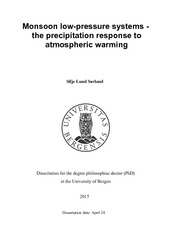| dc.contributor.author | Sørland, Silje Lund | eng |
| dc.date.accessioned | 2015-09-22T09:15:32Z | |
| dc.date.available | 2015-09-22T09:15:32Z | |
| dc.date.issued | 2015-04-24 | |
| dc.identifier.uri | https://hdl.handle.net/1956/10488 | |
| dc.description.abstract | The monsoon low-pressure systems (LPS) are amongst the most rain bearing synoptic scale systems that develop during the Indian monsoon, and they play a key role in generating extreme rainfall events in central India. This thesis consists of three scientific papers, which are devoted to the monsoon LPS, with focus on the precipitation associated with the systems. The main motivation for this thesis is to understand how the LPS precipitation may change in a warming world. To examine this issue, a dataset of LPS developing during the Indian monsoon was generated, described in Paper I. A well know tracking algorithm was used to detect the LPS in the ERA-Interim reanalysis during the time period 1979-2010. The LPS that are connected to observed extreme rainfall events are selected, which resulted in a dataset of 39 LPS. Next, high-resolution, convection-permitting, climate sensitivity simulations were performed on 10 cases chosen from the LPS dataset. Control runs are simulated with unperturbed ERA-Interim initial and lateral boundary conditions (LBC). Perturbed runs follow a surrogate climate change approach, in which a uniform temperature perturbation is specified to the LBC but the large-scale flow and relative humidity is unchanged. The difference between the control and perturbed simulations are therefore mainly due to the imposed warming and moisture changes as well as feedbacks to the synoptic scale flow. The change in the mean precipitation following the LPS is described in Paper II, and Paper III focus on the change in the short-duration extreme precipitation released over central India and the runoff response. The results clearly show that in a warmer and more humid atmosphere, the LPS can produce more precipitation, precipitate with a higher precipitation rate and also bring precipitation further into the Indian continent. Based on these results we conclude that there may be an increased risk of more severe flood events in central India. The more than 2 x Clausius-Clapeyron scaling response in the precipitation is explained by the imposed specific humidity increase, a dynamic feedback giving stronger upward motions and a thermodynamic feedback decreasing the atmospheric stability. In the warmer runs the LPS are more intense with a higher propagation speed. The intensification of the storms seems to be interpretable in terms of the conditional instability of second kind mechanism: condensational heating increases along with lowlevel convergence and vertical velocity in response to temperature warming and moisture increases, and as a result the surface low deepens. The results presented show that the precipitation associated with LPS are very sensitive to an increase in the atmospheric temperature and subsequent moisture increase. Changes in the atmospheric moisture content as a result of temperature warming are together with dynamical and thermodynamical feedbacks, affecting both the precipitation intensity and frequency. | en_US |
| dc.language.iso | eng | eng |
| dc.publisher | The University of Bergen | en_US |
| dc.relation.haspart | Paper I: Sørland, S. and A. Sorteberg (2015). The dynamic and thermodynamic structure of monsoon low-pressure systems during extreme rainfall events. Submitted to TELLUS A. The article is available at: <a href="http://hdl.handle.net/1956/10489" target="blank">http://hdl.handle.net/1956/10489</a>. | en_US |
| dc.relation.haspart | Paper II: Sørland, S., A. Sorteberg, C. Liu and R. Rasmussen (2015). The precipitation response in climate sensitivity experiments of monsoon low-pressure systems over India. Full text not available in BORA. | en_US |
| dc.relation.haspart | Paper III: Sørland, S. and A. Sorteberg (2015). Low-pressure systems and extreme precipitation in central India: sensitivity to temperature change. Full text not available in BORA. | en_US |
| dc.title | Monsoon low-pressure systems - the precipitation response to atmospheric warming | en_US |
| dc.type | Doctoral thesis | |
| dc.rights.holder | Copyright the Author. All rights reserved | en_US |
| dc.identifier.cristin | 1236626 | |
